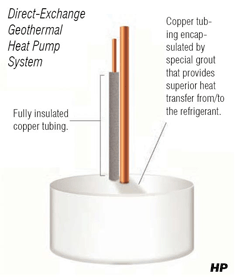What Would Al Gore Choose?
Nobel Environmentalist Goes Geothermal at Home
Competing products all make great claims and seek endorsements that will, they hope, attract consumers. And in today's era of increasing environmental consciousness, being known as a "green" product is quickly becoming the highest accolade of all.
Recently, one high-efficiency home heating and cooling system earned an endorsement of sorts from perhaps the best-known environmentalist on the planet-Al Gore. Although the former U.S. vice president, a co-recipient of the Nobel Prize for his environmental activism, has not publicly lauded his new HVAC equipment, he voted his approval of an innovative groundsource heat pump system by installing one in his own Nashville home and office headquarters.
According to an assistant, Kalee Kreider, Gore was intent on a geothermal system from the start, and a number of options were researched. "He made the final decision on this heat pump technology," Kreider says. "He lives there with Mrs. Gore (Tipper), and he works out of the house."
The new HVAC equipment, manufactured by Earth To Air Systems of nearby Franklin, Tennessee, replaced an older heating and cooling system that had a federal Energy Star rating for efficient operation, Kreider says. "But when you look at overall energy use, this new system is far more efficient."
Installation of the Earth To Air unit included drilling seven small-diameter, 300-foot-deep wells on the Gore property to tap into the earth's constant underground temperatures. Continuous loops of copper tubing were placed in the wells, which were then sealed with a special grout to create a permanent in-ground "radiator" that circulates a liquid heat-exchanging refrigerant.
 High-resolution version of this photo.
High-resolution version of this photo.Ground-source heat pumps work by boosting below-ground temperatures, which average 50 to 60 degrees year-round, to a higher level adequate for home heating. The systems also cool homes during warm weather by returning ambient indoor heat to the ground.
In general, ground-source heat pumps are more efficient than systems that depend on above-ground air temperatures, which vary widely, as their heating source. During very cold weather, air-source systems struggle to close the gap between their thermal starting point and the desired indoor-air temperature. Direct exchange ground-source systems that use copper tubing, like the Gore unit, are also more efficient and considered superior to systems that circulate water through plastic in-ground tubing.
Company vice president David Wiggs says Earth To Air is the first heat pump system engineered to operate with the new, environmentally compatible R-410A refrigerant as a heat-exchange medium. Other systems rely on ozone-depleting R-22 (Freon) refrigerant, which is being phased out and will be banned by the EPA from new installations after 2010.
Andy Kireta Jr., national building construction manager for the Copper Development Association (CDA), consulted on the project to explain the environmental benefits of in-ground copper tubing systems. "Once people see the advantages of copper direct-exchange systems, like this one, they usually go for them," Kireta says. "We're just thrilled that Al Gore wanted one for his own home."
Also in this Issue:
- Going by the Book
- Greening Fire Sprinkler Systems with Copper
- What Would Al Gore Choose?
- Copper's Design Potential Highlights Architectural Seminars
- Return to Glory
